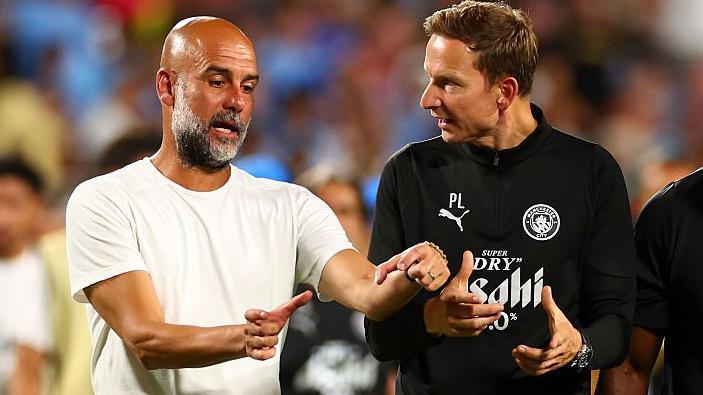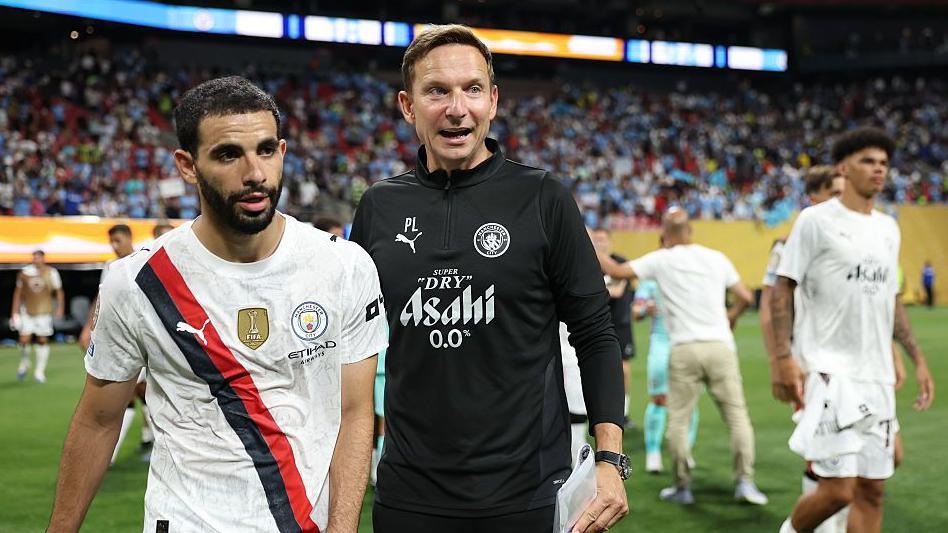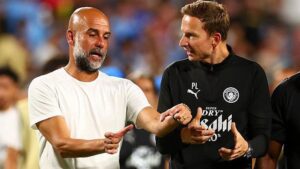Why Guardiola’s new number two could be Man City’s biggest summer signing
Manchester City have spent more than £150m on players this summer but Pep Guardiola’s biggest signing could be Jurgen Klopp’s old assistant.


Manchester City have spent more than £150m on five new players this summer but Pep Guardiola’s biggest signing did not cost a penny – and he will not play any football, either.
In early June, the second-most important coaching figure of Jurgen Klopp-era Liverpool became Guardiola’s right-hand man at Manchester City.
Really, it should have been a bigger news story, not least because hiring Pep Lijnders – a man credited with most of the day-to-day training under Klopp, as well as a substantial part of the German’s tactical evolution post-Borussia Dortmund – suggests Guardiola is considering a major tactical overhaul.
But what’s even more remarkable is that those tactical changes will be navigated with the substantial input of a coach who worked with Klopp on concepts like counter-pressing and attacking in vertical lines; on concepts that served as the antidote to Guardiola’s famous positional play.
That contrast is often overstated, mind. Guardiola and Klopp borrowed from one another, and their shared peaks at Liverpool and Man City almost seem to merge into one perfect blend of Klopp’s dynamism and Guardiola’s control.
On the one hand Klopp’s ‘heavy metal’ football was tamed by an appreciation of territorial dominance, on the other Guardiola used Klopp’s ideas to adapt to the rough-and-tumble of Premier League life.
Nevertheless Lijnders, like Klopp, is far more concerned than Guardiola with aggressive, high-octane attacking football and the opportunities that open up when the ball changes hands.
Until now. Because from the outside looking in, Lijnders’ appointment appears to confirm Guardiola thinks modern Premier League football is moving in the direction of the old Kloppites. And he’s right.

It used to be the case that Guardiola’s territorial suffocation would pin back inferior opponents but, as the middle-class teams got better, those who were bold enough to press hard and disrupt the build-up play started to see rewards.
They quite literally pushed back, until pressing hard and maximising transitions spread across the division and even Guardiola struggled to control things with slow passing and rigid positioning.
“Today, modern football is the way Bournemouth, Newcastle, Brighton and Liverpool play,” Pep Guardiola told TNT Sports a few months ago. “Modern football is not positional. You have to ride the rhythm.”
That’s a huge statement from the man whose ‘positional play’ tactical philosophy pretty much defined the past 15 years of the sport, but it’s spot on.
Over the past five years fast breaks and direct attacks are on the rise, while PPDA – a measure of pressing frequency and intensity, where a lower score means greater pressure – is going down.
When Guardiola made those comments about modern football he was already beginning to experiment with a subtly more direct style of play.
Comparing their 2023-24 to 24-25 campaigns, City’s possession share dropped from 65.5% to 61.3% while their total number of fast breaks jumped from 22 to 30, a rise of 36%.
Most prominently, we saw more long balls from Ederson to bypass the opposition high press and more direct dribbling through the lines from January signing Omar Marmoush.
Marmoush, by the looks of things, was the first signing of Man City 2.0: the rebuild that will shift Guardiola, Lijnders and City into a more Klopp-like direction. More players in that mould have since followed.
Rayan Cherki and Tijjani Reijnders have arrived from Lyon and AC Milan respectively and both signings, like Marmoush, point to more carrying of the ball through the lines and fewer neatly choreographed passing triangles.
To put it more simply, Cherki, Reijnders, and Marmoush are the kind of players who prefer to ride the rhythm.
The data here is stark. Compared with Man City’s three most commonly used central midfielders in 2024-25, Cherki, Reijnders, and Marmoush scored considerably higher for ‘progressive carries’ (a carry of the ball at least five metres towards the opponent’s goal) and ‘attempted dribbles’.
Signing Rayan Ait-Nouri also alludes to Klopp-esque – or Lijnders-esque – football, because having mostly deployed central midfielders or centre-backs in the full-back positions over the past two seasons – an obvious nod to control, order, and discipline – Guardiola has emphatically changed direction.
Ait-Nouri is one of the most attacking full-backs in Europe. Similar to the other three 2025 signings we have discussed, he ranked second for dribbles completed among defenders in the Premier League last season (63) and sixth among full-backs for progressive carries (89).
But more impressively, he was within the top three among defenders for goal involvements (11), expected assists (5.5) and touches in the opposition box (96).
Ait-Nouri’s arrival tells us Guardiola is done with packing midfielders into the team and is ceding some control in favour of more urgent, vertical attacking football.
Just like that, Manchester City fans can go from worrying about their team’s slow and passive football to wondering how such an explosive attacking pair as Ait-Nouri and Jeremy Doku could work together on the left, or how Marmoush and Cherki will fit into the same attacking midfield space.
They will certainly have more questions than answers before the 2025-26 Premier League campaign gets under way, because most of their new arrivals – on the pitch and in the dugout – just don’t fit the usual Pep archetype.
Clearly Guardiola is working on something new. With Lijnders at his side, it could be his sharpest left turn yet.








